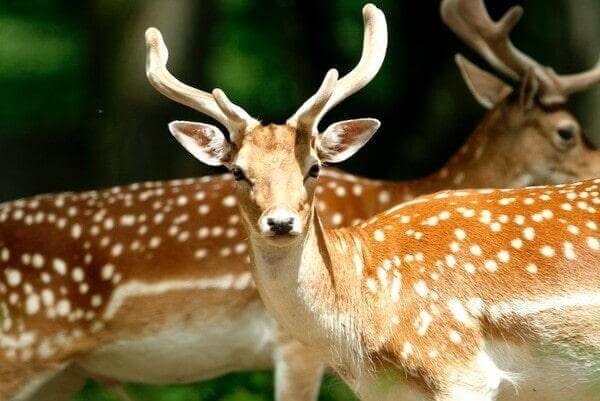Author: Randeep Singh / go to all articles on Yoga Concepts

Among the cultural expressions
and psychosomatic techniques,
of India’s spirituality,
yoga talks about the necessity of
performing these techniques,
like prayers with certain
considerations of dressing, decorating the house and surroundings in a certain way,
in particular the meditation and the prayer room etc.
Kusagrass and deer skin are considered as the traditional furniture of the meditation, or prayer room. Tradition mentions a deer skin, a cheetah skin, lion, or a tiger skin to be used as a mat on which one performs one’s meditation practice. Why a deer skin as a yoga mat ?
The use of a skin as a seat might well have originated in the desire to offer a better or the best seat available in the house – in the absence of any arm chairs, carved and cushioned – to the head of the family or the tribe, or to an honored guest. The rarer the animal was, the more difficult was to get at its skin, the more precious and honourable it would have been to offer it as a seat. Even now, wealthy mansions their like to adorn their living rooms, walls and floors, with such trophies.
Hence, the usual and quite reasonable ritual and liturgical conservatism may have come to reserve it for those dedicated to God and for certain activities dedicated to him. In any case, the custom to sit on them, or even to wear them for religious purposes seems to be as old as India’s civilization. It is said that a cheetah, a tiger or a ion skin if used for yoga practices ensures greater spiritual development. Some praise the tiger skin as ” having got its own advantages.” It generates electricity in the body quickly and does not allow leakage of electric current from the body.
It is full of magnetism ( Swami Sivananda). Whatever be the truth about these statements – barring magic and superstition, I am not qualified to judge them – there is no gainsaying that the violent, carnivorous ferocity, associated with the cheetah, the tiger, and the lion do not align well with yoga, especially for prayers and meditation. This character of these canine skins is also not in tune with any of the yamas or niyamas as enumerated in the Ashtanga yoga of Patanjali. The deer skin, on the contrary fits into the concepts of yoga in real as well as symbolically.
Deer prefers Clean and is Non-Violent – Skin as Yoga Mat
The deer is believed to never intake unclean food, or unclean water – it declines a half eaten banana or an already bitten mango. That is why it came to be taken as a symbol of purity, both of body and soul, of saucha and brahamcharya. Further, the dear is vegetarian and an embodiment of non-violence – ahimsa. It breathes innocence and candor – satyam. Besides, how light and swift and surefooted is its graceful slimness, apparently quite detached from the weight and sluggishness of matter.
Its lightness and swiftness suggest of the wind and the spirit. The wind blows wherever it pleases, one can hear its sound, but its difficult to know its direction of flow. That is how it is with all who are born of the spirit. The Christina scriptures too appreciate the obvious significance of the deer’s spirit like promptness in spite of, also because of, the wispy lankness of its frame. “Then the lame will leap like a dear…….” Isaiah XXXV,6 and acts III, 8; ” Yahweh, my lord, is my strength – he makes my feet as light as a doe’s……” Habba -kkuk’s last verse.
The Sastras declare that the dharma thrives where the spotted deer resides, and that the rishis, people with the eremitic and prophetic vocations, are reported to have been choosing their residences and spending their lives preferably where it lives in abundance. One cannot but love the inspiration derived from being carried by the deer when one desires to enter the realms of meditation and prayer. The Bible too echoes this symbolic suggestiveness, f.i., in Psalm XLII, 1 ” As a doe longs – for running streams – so longs my soul- for you, my God. The Bride of the Canticle of Canticles sees in it an apt simile of the divine object of her overwhelming bhakti: “I hear my beloved – see how he comes – leaping on the mountains – bounding over the hills – My beloved is like a gazelle, – like a young stag.” (II,9).
And the divine lover reciprocates: ” I charge you, – daughters of Jerusalem, – by the gazelles, by the hinds of the fields,- not to stir my love (the Bride), nor rouse it- until it leases to awake,” (II,7),
Other Informative Articles….
